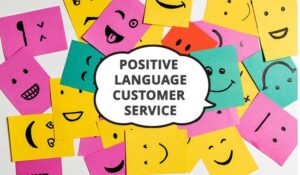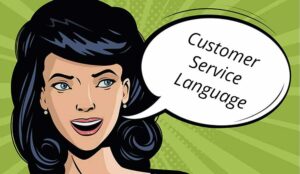Liz Doig of Wordtree discusses how you can ensure that your contact centre is using language that supports great customer service.
Why Customer Service Language Matters
A customer has decided to subscribe to your services because, out of the many companies they have researched, yours sounded friendly and accessible.
The customer goes to write an email to you, but something doesn’t seem to be working right. They move across to chat to get the problem sorted, expecting to have a quick and easy interaction with a friendly person to fix things.
- Webchat handler: ABCInternet. Please describe the nature of the issue.
- Customer: My problem? Er, OK… my emails don’t seem to be sending properly – but only from my phone.
- Webchat handler: Please check your SMTP server settings in mail preferences and verify any advanced settings with your system administrator.
- Customer: I’m sorry, I don’t understand what that means. What’s an STM… thing?
- Webchat handler: Search in mail preferences…
This is not what the customer was expecting. For starters, the chat handler assumes that the customer knows technical phrases. They also sound incredibly robotic.
The exchange goes on like this and the customer gives up and clicks off. They’ll ask a friend.
Over in a completely different business, a man emails customer services to see if he can add a present to the flowers he’s ordered for his mum.
He knows he’s dealing with a national florist, but the website seemed to be very family-oriented and – though he probably wouldn’t use exactly these words – he expects to be well cared for.
This is the email he gets back:
Thank you for your email of June 12, 2020. I can confirm that you have requested to change the details of your delivery.
We always work to exceed the expectations of our customers. However, you will note from our terms and conditions that it is not possible to change orders once they have been processed. I have checked the live status of your order and it was processed at 9.48 BST.
Should you wish to make a further purchase, please visit our website at Verygorgeousflowers.com.
Well that’s a shame, he thinks – and decides to order a gift from Amazon instead. He makes zero effort to remember Verygorgeousflowers.com.
If you’re looking for quick examples of good customer service language, read our article: Positive Language for Customer Service Conversations
Outcomes vs. Language
The sceptical reader might look at both of the situations above and think: Well, the customer wasn’t going to be happy in either situation. We can’t change the rules just to keep customers on side…
But here’s the thing – people can accept all sorts of news and updates and be happy about them if the language is right. And maybe we can sometimes change the rules, just a little bit.
The chap who wanted to send his mum a present is potentially a great customer. He could become loyal for life, if Verygorgeousflowers.com lives up to the unspoken promise on its website – which is to care about family occasions.
Assuming the order has been processed, and there’s nothing Verygorgeousflowers.com can do about that – an email like this would still made him feel like he’d chosen the right company (and recommend it to others):
Hi Fred,
How lovely of you to want to send a present to your mum as well.
I’m so sorry, though, I can’t add one to your flower order this time – as it’s already been processed.
But I’ve attached a voucher code so that you won’t have to pay for delivery when you go back to Verygorgeousflowers.com to choose an extra something for her. (Personally, I know my mum loved our bath bombs… and we have a range of chocolates including vegan and diabetic options, if you think she’d like those.)
I hope this helps – and please wish your mum a happy birthday from us all here!
Lydia
The basic information hasn’t changed. Fred still can’t add a present to the order he made. But the wording has transformed Fred’s customer experience.
Importantly, the second email feels like the same company he ordered the flowers from – one that cares and that has a strong family vibe.
So, How Do You Make the Change?
Language is something that seems simple but is actually rooted in something quite complex. And that something is culture.
Now, there are contact centres that have an absolutely wonderful, customer-centric attitude and that are filled with caring people – and that have just adopted lacklustre customer service language.
Usually, this is because at some point the contact centre decided that this is what “proper customer service communications” looked like. And in these situations, robotic language is often hiding a lovely culture and making it seem uncaring.
And then there are contact centres where the culture itself needs fixing as part and parcel of changing customer service language. Or in other words, their crappy wording is a result of a culture that doesn’t prioritize people.
One of the many wonderful things about changing your customer service language, though, is that you can use the exercise to redefine and reshape working culture too.
With this in mind, here’s what you do:
1. Start With Your Brand
Does your organization have defined brand values, personality and positioning? If it does – and you have a marketing and brand team who look after them – start there. If your organization has these things, it’s likely that it also has a defined “tone of voice”.
“Tone of voice” is brand terminology for the way your organization communicates. It’s a confusing name because it isn’t about the way you say things out loud. “Tone of voice” is, in fact, more about how the words you use come across and make you sound.
Your brand tone of voice should come with a set of guidelines that explain how to use language to express your organization’s personality in a range of situations.
So as a starting point, talk to your colleagues in brand and marketing and ask them:
- if your organization has a defined tone of voice
- if you can work together to adapt it for customer services.
If your organization has a workable tone of voice with guidelines that can be immediately put into use, you can jump to step 5.
If your organization doesn’t have a tone of voice (or it turns out that it does, but it hasn’t been developed enough to work in your contact centre) then steps 2-4 are for you.
Even if you’re thinking of developing a tone of voice from scratch, keep talking to your colleagues in marketing and brand – and talk to them about footing at least part of the costs of the project.
For more on developing a tone of voice throughout your organization, read our article: 5 Simple Tips for Improving Tone of Voice in Customer Service
2. Assess the Customer Service Language You’re Using Right Now
Take a comprehensive sample of all the customer communications you’re generating right now. This should include everything you write down – including scripts, prompts, letters, emails and chats – as well as any standard wording (including legal wording) that you copy-paste into communications.
Also, listen in to phone conversations or recordings of them and make notes. What you’re trying to do here is not just capture the topics that are being discussed, but the words that they’re expressed in.
Then, sit down and compare all of the communications.
What assumptions would you make about a person who communicated using the words you’re looking at?
As an example, what would you assume about people who greeted you in these ways?
| Greeting | Wotcha! | Good Morning to You my Fine Fellow | Hi! | Hello | You are though to… |
|---|---|---|---|---|---|
| Possible assumptions about the kind of personalities that would use it: | Informal, Friendly, Maybe not highly educated | Posh, Educated, Over the Top, Old Fashioned | Friendly, Polite, Modern | Natural, Polite | Colder, Maybe not so friendly |
How are your communications making you seem to outsiders? And does the personality you “feel” speaking in your communications match the one your customers encounter on your website or in your stores?
Don’t be surprised if you find that your “tone” or “tone of voice” jumps around – sometimes feeling informal, sometimes a little cold and off-hand – and sometimes like a lawyer wrote it with a quill in 1889.
What you have to remember is that consistency is important. You don’t want your customers to feel like your organization only cares about them when there are no problems – or before it gets their money.
Which is what it can seem like if your pre-sales communications are super-friendly and your post-sales communications are stiff, difficult and cold… or just mixed.
You also don’t want a customer who’s in touch with you several times to get a different tone with each communication.
For more examples of how to greet customers – like in the table above – read our article: The Best Customer Service Greeting Phrases – With Examples
3. Find Out What Your Teams Think About the Way You Communicate Now
Involving your teams is important. They are very likely to have important insights about the way your organization communicates. They’re also going to have (sometimes strong) views about the wording you use right now.
If you’re going to persuade them to change their views, you need to know what they’re thinking. (And you never know, they may persuade you that you need to adapt your thinking instead.)
You can also find out from your teams what they struggle with right now, what they’re proud of and what they’d like to change. All of which will:
- help your teams to feel involved from the very start
- help you to handle the change with sensitivity.
4. If You Don’t Already Have a Defined Tone of Voice, Create an Approach, With Guidelines
Let’s imagine that you’re creating a tone of voice for Verygorgeousflowers.com. The organization knows that its customers expect them to be warm, caring, open and professional.
They also want it to be seen as a modern brand that understands the pressures and dynamics of modern family life.
This means that tonally, its customer service language is going to be somewhere around the third or fourth column of our table in point two (“hi” and “hello”, rather than “wotcha” or “good day to you…”). It means their language should feel conversational and easy – even when it’s written down.
So, the bouquets-by-post company sets out some guidelines for using customer service language, complete with examples that cover all different types of communication and situation.
It ties its use of language to one big idea – “modern family friend”. This means its language will always make it sound like a member of the family and will always be appropriate for modern families.
If ABCInternet decided to create a tone of voice, it might take a slightly different approach. Instead of one big idea, it might decide to align its customer service language to the three things it most wants to be known for:
- easy access
- high speed
- powering your business
So its tone of voice guidelines might include advice like this:
| Greeting | Wotcha! | Good Morning to You my Fine Fellow |
|---|---|---|
|
We make accessing internet service easy. And that means we don’t bog people down with jargon and technical words. Before you talk to a customer or write everything down, think: Would my mum/best friend/flatmate understand this? |
Everything about us has to give the impression of fast-flowing information. So, don’t use ten words where only two are needed. Don’t be afraid of using contractions (I’ll, you’ll, it’ll). |
Our customers are running small businesses and they need us to be an extended part of their team. So, use words that show we have a strong relationship: “you”, “your”, “us” and “our”. |
The webchat we looked at in the first section of this article might have gone very differently if these guidelines had been followed:
- Webchat handler: Hi, you’re speaking to Adnan at ABCInternet. How can I help you today?
- Customer: Right, well… my emails don’t seem to be sending properly – but only from my phone.
- Webchat handler: OK, that sounds like something we may be able to sort out in your phone’s mail preferences. Have you got your phone with you?
- Customer: Yes, it’s here…
- Webchat handler: Great, so click on your settings icon…
The approaches to language for Verygorgeousflowers.com and ABCInternet are not interchangeable. What’s right for one company might not be right for yours at all.
To work out what is right for you, start with what you want to be known for and how you want to make your customers feel. Then decide what kind of customer service language will help you to achieve this.
5. Assess Key Metrics Right Now
Before you begin to introduce a new tone of voice and ask people to use it, check what your metrics are like right now.
- What are first time resolution rates like?
- How many five-star ratings are you getting?
- How many people are complaining (or going to the Ombudsman?).
- How happy are your teams?
- What are your attrition rates like?
Language is everywhere in your organization. It’s impossible to work without it. And this means that it affects everything too.
Which is great news when you want to make changes – because when you change your organization’s language, you can’t help but change its culture too. And this means that it’s not unusual for people to become happier in their work – and for customers to become happier with the service they receive when you change your approach to using language.
The important thing is to measure before you start – and then to keep measuring as you roll out changes in language across your teams. This will give you a great benchmark.
For more on creating internal benchmarks, read our article: Contact Centre Benchmarking – How to Get More From Your Metrics
6. Raise Awareness Amongst Your Teams
Changing the language of your call centre isn’t something you’re going to be able to achieve overnight. You don’t flip the switch and go from one style of language one day to something completely different the next.
This is because you have to persuade people that the change is worth making – and give them the tools to be able to do it.
So you start by raising awareness and letting people know that you’re going to be changing your approach to communications, that you want everyone to be involved and that it will make working life easier and more fun and will get better results.
Begin to show people what the changes will look like – and outline the support that will be in place to help them make the change.
Tell your teams that their help has been fabulous, this is where you are right now… and what the next steps will be.
7. Train People to Use It
Training in a contact centre can be difficult to accommodate – so break your training down into manageable chunks that won’t have too many people away from their stations all at the same time.
Initial training has most impact when it’s face-to-face – either around a table in the same room or on video conferencing.
Face-to-face training gives people an opportunity to ask questions, express any misgivings and have them discussed openly – and to hear and see how their colleagues respond to changes.
Done well, customer service language training is a lot of fun – and should make people feel empowered and eager to get out there and start doing it differently.
Follow-up and refresher training can be done online.
If you outsource contact centre support, train external teams too and get them to understand why your language has to be different from your provider’s other clients. Because the last thing you need is for your customers to feel you only provide a generic call centre experience for them.
And remember, customer service language training isn’t like a lot of other training. It isn’t simply a matter of learning a new set of facts (for example, like if you were training your colleagues about an update to regulations). It isn’t like learning English at school either (or at least, it shouldn’t be).
Commercial language training is nuanced, and it should be trained by people who have a lot of experience in business communication.
When you’re looking for trainers, try to find people who have deep knowledge of this complex area – but who can make it all feel simple, achievable and enjoyable for your teams.
In fact, if you find an external agency that can both create your tone of voice and train it in this way, you’ll be on to a winner.
Find out how to train good writing in the contact centre by listening to the following episode of The Contact Centre Podcast, featuring a conversation with Leslie O’Flahavan.
The Contact Centre Podcast – Episode 15:
Customer Service Writing: How To Get More From Your Emails And Chats
For more information on this podcast visit Podcast – Customer Service Writing: How to Get More from Your Emails and Chats
8. Make Language Part of Quality Assurance (QA)
To make sure your new approach becomes business as usual, it’s useful to think about scheduling regular refresher training.
It’s also imperative that it becomes part of QA. Let your colleagues know that you’re going to be assessing performance – at least in part – on the words they use to communicate with customers.
Giving your QA team responsibility for customer service language can also be a real help when it comes to making the shift. This could involve training members of your QA team to become language trainers and champions.
Also, it could mean that they’re the first points of contact when anyone has questions about a new communication they’re creating.
And if you outsource, then make customer service language QA a part of the contract with your provider – and part of your conditions for renewal.
Find out how to best lay out your QA scorecard criteria in our article: How to Create a Contact Centre Quality Monitoring Scorecard – With a Template Example
9. Let the Rest of the Business Know What You’re Doing – and the Results You’re Getting
Undertaking a project to change the language in your area of the business is a big deal – so let your colleagues across the rest of the business know about it.
If you have a forum like an intranet where you can share progress and ideas, then use it. If you don’t have this – why not send out a monthly mail to the rest of the business anyway?
Share with your colleagues what you’ve been doing, what it has achieved, and why and how it’s delivering an even better, more brand-aligned experience to customers.
Letting the rest of the business know about your language programme will:
- share some great ideas
- raise the profile of your work and your area of the business.
10. Reassess Regularly
Customer service language is powerful stuff. Even small changes can have big effects. But it can also have a mind of its own – so make sure you keep on top it.
When new people join, make sure they receive training. And keep checking.
Are some of your templates beginning to sound a bit old-style? If you’re getting lower satisfaction rates in some areas, could this be linked in any way to the language used in those templates?
If you build in processes to keep on top of language, you’ll be able to keep it in great shape, help to improve customer and team satisfaction – and have a higher profile across the rest of your business.

Perhaps most importantly, you’ll be maintaining a special experience for your customers, so they feel heard, seen and valued whenever they come into contact with you. Because this is what’s going to turn a customer into a fan and cheerleader for your organization.
Written by: Liz Doig at Wordtree
For more on how you can best use customer service language across the contact centre, read our articles:
- The Best Courtesy Words and Phrases to Use in Customer Service
- The Best Power Words and Phrases to Use in Customer Service
- How to Write a Good Customer Service Letter – With Examples
Author: Liz Doig
Reviewed by: Hannah Swankie
Published On: 22nd Jul 2020 - Last modified: 15th Dec 2025
Read more about - Skills, Editor's Picks, Language, Liz Doig, Positive Words, Rapport, Skill Development





































